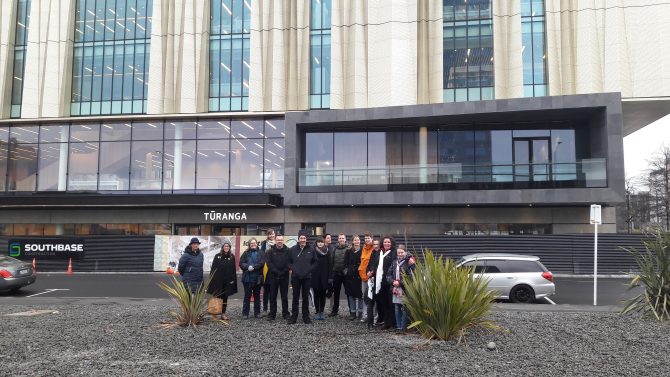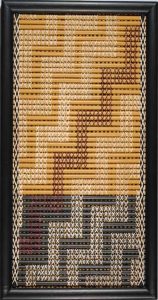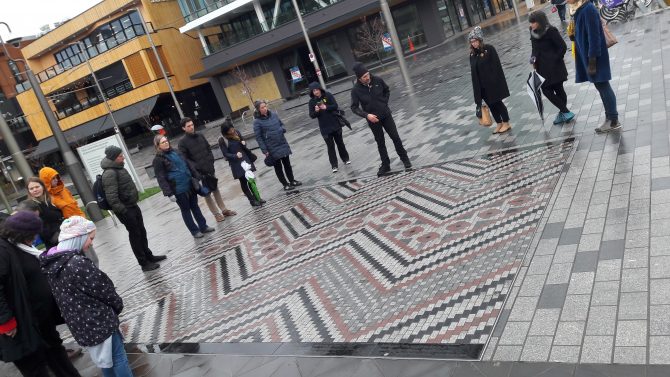It was a chilly, damp, blustery and all-over a very Christchurch kind of day on Friday. Sheltered in the foyer of the Piano was a small and well-wrapped group of people, both long-term locals and people visiting just for the weekend, waiting for our 90 minute tour of the central city with Joseph Hullen (Ngāi Tūāhuriri/Ngāti Hinematua). I was really looking forward to it - I love finding out the stories behind a place, how human histories are represented in art and design. Joseph, and Ōtautahi - did not disappoint. The work that Matapopore, opens a new window has put into Ōtautahi Christchurch is incredible.
We started the tour in Victoria Square, opens a new window, near the site of Puari, a Waitaha Pā. The square was later known as Market Square after colonial settlement, and Joseph talked about the European design of the square and how it's a bit... higgledy-piggledy (my word there, not his). Queen Victoria faces toward a building that isn't named after her, faces away from a street that is named after her, and the closest figure to her is James Cook, a man she shares no whakapapa with. Their life spans never even crossed over.
In 1857, Ngāi Tahu rangatira, Matiaha Tiramōrehu, opens a new window, wrote a letter to Queen Victoria calling "That the law be made one, that the commandments be made one, that the nation be made one, that the white skin be made just as equal with the dark skin." These words, and more from his letter, now adorn the tall windows of the Hereford Street entrance of Te Hononga, the Christchurch Civic building. A lovely link between Victoria Square and the Council building.
Our second stop was our very own Tūranga, the new Central Library. Joseph told us the story behind the naming of the building as he explained the artwork carved into the stone above our heads. Tūranga was the place that Ngāi Tahu ancestor Paikea landed in Aotearoa, after his journey from Hawaiki on the back of a whale. It is a fitting name for a library - a repository of knowledge - as Paikea bought with him all the wisdom and knowledge from his homeland. The art on the side of Tūranga represents migration stories, and the pathways that bring people from all over the world to our shores.
Another thing to note, when standing directly under Tūranga and looking up at the building, is how ABSOLUTELY MASSIVE it is! Phwoar!
Next we ventured down toward Te Hononga on Hereford Street to see Matiaha Tiramōrehu's words on the windows, and explored the art and the rain gardens across the road at the Pita Te Hore Centre, where the old King Edward Barracks used to stand. Before the barracks, it was at the edge of the Puari Pā site. Joseph drew our attention to the banks of the river and the fact that the side we stood on was higher ground than the other - a very sensible place to build as it was much safer when the river flooded!
There's a lot to see in the Pita Te Hore Centre, the landscaped courtyard in the centre of the office buildings is gorgeous. The stormwater is all treated on site in the rain gardens which are full of native plants. A moving sculpture, called Pupu Harakiki, commemorates Lisa Willems who died in the 2011 earthquake. Another sculpture, Kirihau - Resilience, speaks of the kaha - the strength and resilience of the tuna - the long finned eels - to adapt to their environment and it acknowledge the durability and adaptation of the people who live here as well.
The tiles under our feet are laid out in a poutama pattern - it looks like a series of steps, climbing toward excellence. The pattern also represents the pathway that the local soldiers took during World War One - out of the King Edward Barracks, across the river, toward the train station, over to the port at Lyttelton, and off to war.
We followed the same path as the soldiers across the river (although there is a bridge there now - the soldiers at the time trudged across the water), across the Bridge of Remembrance. In front of the bridge is one of the series of 13 Ngā Whāriki Manaaki - woven mats of welcome. This one, Maumahara, remembers the men and women fallen in battle. Images of poppies are woven into the pattern that represents the march to war, and the journey after death to the spiritual realm.
Next we stepped down toward the river where little tuna were poking their heads out from beneath the steps, drawn out by Joseph's tempting fingers on the water. This whole area was a mahinga kai - a food gathering place - rich with tuna. This started a discussion among the group about sustainability - you get heaps more protein and calories from an acre of tuna than you could ever get from an acre of cows, and farming tuna is much better for the environment than farming cows.
Onward we walked to Hine-Pāka, the Bus Interchange, where the artwork on the ground in front of the entrance understandably represents navigation. Joseph drew our attention upwards too. Ngā whetū, constellations used for navigation, adorn the ceiling.
From the exchange we looped up Manchester Street, where the high density housing in the East Frame is going in - and the greenery around it in the Rauora Park. There's also a basketball court and climbing frame - places to play are a vital part of any residential area.
Finally we heading back past Tūranga for a group photo, then back to the Piano where members of the group thanked Joseph with a waiata, a moving close to a really brilliant tour.
Find out more
- Find out more about the Māori history of Christchurch with Tī Kouka Whenua
- Find out more about Matapopore projects around the city
- Follow our coverage of WORD Christchurch Festival 2018






Add a comment to: Te Ao Hou – Weaving indigenous identity back into Ōtautahi: WORD Christchurch Festival 2018